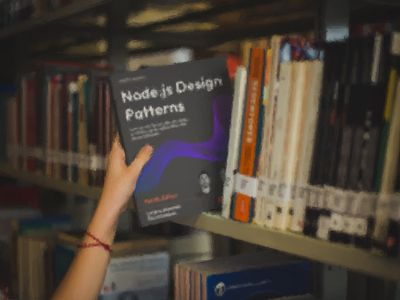Articles tagged #node-js

Node.js Design Patterns: Fourth Edition is out!
The fourth edition of Node.js Design Patterns is here. As one of the authors, I share why we wrote a new edition, what's new, and my thoughts on where Node.js is heading.

Migrating from Gatsby to Astro
This article discuss the reason why I wanted to migrate this blog from Gatsby to Astro and the process I followed to do it. Plus a bunch of interesting and quirky bugs that I had to troubleshoot and fix along the way.

Middy 1.0.0 is here
The middleware framework Middy reached version 1.0, bringing middleware capabilities to AWS Lambda. This allows cleaner handler code by extracting cross-cutting concerns into reusable middleware.

Lean NPM packages
Learn how to configure NPM packages to publish only the files needed by users, avoiding bloating node_modules folders.

Fastify and Preact for quick web app prototyping
This article shows how to quickly build web app prototypes using Fastify for the backend API and Preact for the frontend UI. It also covers how to dockerize the app for easy sharing. Key points are the plugin architecture of Fastify, the lightweight nature of Preact, and the use of htm for defining UI without transpilation.

JavaScript iterator patterns
This article explores different ways to create iterators and iterable values in Javascript for dynamic sequence generation, specifically using functions, iterators, iterables and generators. It provides code examples for implementing the Fibonacci sequence with each approach.

Emerging JavaScript pattern: multiple return values
This article explores how to simulate multiple return values in JavaScript using arrays and objects. It covers use cases like React Hooks and async/await error handling. The pattern enables elegant APIs but has performance implications.

My Serverless talk at Shift conference in Split
Luciano Mammino recounts his experience speaking at the Shift conference in Split, Croatia about Serverless architecture and its pros and cons. He provides links to his talk video, slides, and a Twitter moment.

My Universal JavaScript Web Applications talk at Codemotion Rome 2017
The author gave a talk on building universal JavaScript web apps at Codemotion Rome 2017. He updated his Judo Heroes demo to v2 with React 15.4, React Router 4, Webpack 2, and Express 5. The talk got positive feedback from the audience. Slides and video are linked.

Unshorten (expand) short URLs with Node.js
This article explains how short URLs work and provides code examples to expand them in Node.js using request module or tall library. It covers basics of URL redirection, shows how to disable auto-redirect in request module, and introduces tall - a promise-based Node.js library to unshorten URLs.

My Serverless & AWS Lambda talk at Node.js Dublin January 2017
This post summarizes a talk about building a serverless architecture on AWS Lambda using the Serverless framework. It covers topics like authentication, authorization, testing, CI/CD, and cost monitoring. The presenters share lessons learned from real-world experience building a production serverless application.

My Universal JavaScript Web Applications talk at Codemotion Milan 2016
This blog post summarizes a talk about building a Universal JavaScript application with React given at Codemotion Milan 2016. It includes commentary for each slide, photos from Twitter, and a video recording. The post explains what Universal JavaScript is, its benefits, challenges, and walks through demo code to add server-side rendering and routing to a React app.

How to crack a JWT token: two articles about distributed computing, ZeroMQ & Node.js
This blog post explains how to build a distributed application using Node.js and ZeroMQ that cracks JWT tokens. It provides a step-by-step guide on implementing the application and links to two in-depth articles on RisingStack that cover the theory and coding details.

Two Interviews about Node.js, JavaScript and being a book author
Luciano Mammino recently participated in two interviews discussing his work with Node.js and JavaScript as well as his experience as an author writing books about Node.js design patterns.

React on the Server for Beginners: Build a Universal React and Node App
This article explains how to build a simple Universal JavaScript application using React, React Router and Express. It shows how to implement server side rendering with React and Node.js to create an isomorphic app.

Announcing the book "Node.js design patterns - second edition"
The author announces the release of "Node.js design patterns - second edition", a new book covering design patterns for Node.js and JavaScript. It includes updated code for Node v6 and ES2015 across 11 chapters and 100+ examples.

To promise or to callback? That is the question...
We explore two approaches to support both callbacks and promises in async JavaScript modules: 1) promisify callback functions, 2) make callback optional and return promise. The second allows flexible use of callbacks or promises.

Introducing Gulp cozy - Manage your gulp tasks in a cozier way
Gulp-cozy is an experimental NPM package that allows you to separate Gulp tasks into small modules inside a dedicated folder, making them easier to maintain. It brings Node.js modularity principles into your Gulp workflow.

Introducing mongo-uri-builder, a Node.js module to easily create mongodb connection strings using objects
The mongo-uri-builder Node.js package easily generates MongoDB connection strings from configuration objects, supporting features like authentication, replicas, and options. It integrates well with config for managing different environments.

Having fun with Node.js, Slack and Chuck Norris
A tutorial was published on how to build a simple Slack bot in Node.js that tells Chuck Norris jokes, for some amusing fun. The bot is open source and available on GitHub and NPM.

Versioning and deploying a static website with Git, Flightplan and Nginx
This blog post provides a beginner's guide to managing versioning and deployment of static websites using Git for version control, Flightplan.js for automated deployment, and Nginx for serving. It outlines a simple yet complete workflow for implementing continuous delivery and rollbacks.

Introducing flickr-set-get a command line app to download photos
The flickr-set-get command line app makes it easy to download entire Flickr galleries. It uses the Flickr API and Node.js asynchronous programming to download photos in parallel. The post explains the motivation behind the project, the technologies used, and how the asynchronous code works.